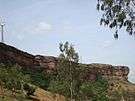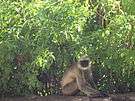Gajendragarh
Gajendragad (also called Gajendragada) (Kannada: ಗಜೇಂದ್ರಗಡ) is a town and a taluk in Gadag District, Karnataka, India. The name Gajendragad has its own history. This place is known for its hill station and hill strip. Highest populated city after Gadag in the district. It is about 55 kilometers from Gadag, 110 kilometers from Hubballi and 450 kilometers from Bengaluru.
Gajendragad ಗಜೇಂದ್ರಗಡ | |
|---|---|
Town and Taluk | |
| Gajendragada | |
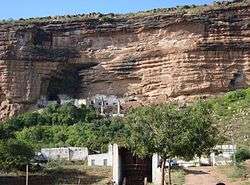 Kalkaleshwara Temple at Gajendragad. | |
| Nickname(s): Gada | |
 Gajendragad Location in Karnataka, India  Gajendragad Gajendragad (India) | |
| Coordinates: 15.73°N 75.98°E | |
| Country | |
| State | |
| District | Gadag |
| Taluk | Gajendragad |
| Lok Sabha Constituency | Haveri |
| Founded by | Chatrapathi Shivaji |
| Named for | Hill Station |
| Government | |
| • Type | Tehsil |
| • Body | Taluk panchayat |
| Elevation | 643 m (2,110 ft) |
| Population (2011) | |
| • Total | 32,359 |
| Languages | |
| • Official | Kannada |
| Time zone | UTC+5:30 (IST) |
| Vehicle registration | KA 26 |
| Website | www.gajendragadatown.mrc.gov.in |
| Largest city after Gadag in the district. | |
Introduction
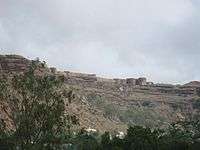
Gajendragad (Gajendra-Elephant, gad-fort), is a historical place in the Gadag district. The name Gajendragad is a combination of Elephant and a fort. This is because the city looks like elephant body in the bird view. Local people generally call it as Gada. It is about 55 km from Gadag and is one of the big town in the Gadag District.
Gajendragad is known for film shooting because of its even land on its hills. It is a place where several films are shot. Several Kannada films including Veera Madakari, Brundavana, Raate, Jaanu, Bahuparak, Bheema teeradalli, Bharjari, Rakshit Shetty's Avane Srimannarayana(ASN), Rambo 2, Bharate and many more. The name 'Gajendragada' is cited in the introduction of Kichcha Sudeep's multi-lingual movie 'Pailwan'. Bollywood Salman Khan's Dabangg 3, Telugu movies like Damarugam, Alludu seenu, Brundavanam, Balupu Bharjeri and many more are also shot here.
Gajendragad is a pilgrimage destination due to its Kalakaleshwara temple.
It is known for the long hill strip, hill station, film shooting spots, fort, kalakaleshwara temple, market for Javali / Dress Materials for marriage and festivals, windmills, Handloom, Gajendragad Kubusa Kana.
History

Gajendragad is surrounded by the historical places associated with Badami Chalukyas and Western Chalukya and the places are Badami, Aihole, Pattadakal, Mahakuta, Banashankari, Sudi, Mahadeva Temple at Itagi and Kudalasangama. Rastrakuta Monuments at Kuknur. Gajendragad Fort was built and renewed by Shivaji.[1][2]
Ghorpade
Founder of the Ghorpade family was Shri Valabhasinh Cholaraj Ghorpade and then the descended Bahirjirao (Hindurao) Ghorpade
The Royal families of Kapsi and Gajendragad[3][4] owe their origin to Vallabhasinha and the Chiefs of Sondur are descended from the third son of Cholraj.
Treaty of Gajendragad
After the 2nd Mysore War, Tippu Sultan had to engage in an armed conflict (during 1786–87) with the Marathas and the Nizam. The war concluded with the treaty of Gajendragad.[5] Tipu Sultan ceded Badami to the Marathas.[6]
The fort and Taluka of Gajendragad which was taken by Fate Alikhan was retaken by Maratha Government. Half the province was surrendered to the Nawab (Nizam A. D. 1786–87) according to Treaty of Gajendragad. Remaining was made over to Dawalatrao Ghorpade (Rs, 50,001 was taken from him).[7]
Tourism
The pilgrim Kalakaleshwara temple, is a huge mountain with the temple carved into it. This is a weekend destination which could be wound up in a day's time. One can see many windmills lined on the hill opposite the hill on which the temple is located.
Kalakaleshwara temple
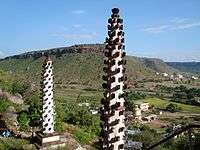
A little known pilgrim of North Karnataka. Gajendragad is a small town lying amidst hills, in one of which is encapsulated Kalakaleshwara temple of Lord Shiva (known as Dakshina Kashi), who is worshipped in the form of Kalakaleswara. There are some large steps that lead you up to the temple. It is a traditional temple with Udhbhava Lingu. There we can find God Virabhadra temple also in the same premises. But one would definitely be amazed at the story in which the significance of the destination lies. Just outside the temple exit is a small square water reservoir called AtharaGange. It is an evergreen water resource that constantly falls along the roots of Peepal tree into the pond all throughout the year. It is said to be flowing even in the peaks of summer season and has an unknown root.
Mythology
More amazing is the story attached to this destination that has taken a few lives too. These were the daring people who wanted to try to learn more about a miracle that happens on the previous night of Ugadi, New Year of Kannadigas. The pandit/pujari of the temple prepares a solution of limestone, and keeps it ready for application along with a brush, inside the temple. The next morning, the jobs done. But the temple is painted on its own and this happens without fail every year. A hookah that is also kept along with it seems to be used when seen the next morning.
Legend has it and so do elderly people that there used to be a bell equivalent to the size of soaked kidney beans that fit into 22 gunny bags. In the 1970s, it so happened that the bell vanished all of a sudden towards the heavens, ringing and sounds of the bell echoing and resonating in into the blue skies. And then there was an epidemic of plague that spread across the place, which people blame was due the bells act of vanishing.
Tourism of Gajendragad region
Sudi
Mallikarjuna Temple, Twin Towered Temple, Ishwara in a stone made shelter and Naga Kunda are prime attractions of Sudi.
Itagi Bhimambika
The temple of Bhimambika, about 13 km from Gajendragad
Banashankari
It is known for temple of Banashankari, and Annual car festival.
Badami, Aihole, Pattadakal and Mahakuta
Mahakuta is the source of an important Badami Chalukya inscription called Mahakuta Pillar inscription.
Kuknur
MahaMaya temple, Navalinga Temples at Kuknur.
Kudalasangama
At Kudalasangama the rivers Krishna and Malaprabha merge (sangama) here, This place is closely associated with the 12th-century poet and social reformer Basavanna. There is a temple dedicated to Lord Sangameswara, worshipped in the form of a linga. The temple is an ancient monument built in the Chalukya style architecture. This place is well developed as one of the great tourism place.
MMTC's wind farm
Minerals & Metals Trading Corporation (MMTC) Limited under the ministry of commerce and industry. MMTC's Gajendragad plant Started in 2007, the plant has delivered electricity power of over 102 million units to Hubli Electricity Supply Company (HESCOM) Limited.[8] The plant generate a total capacity of 15 MW of power, with 25 wind energy generators, can each generate 600 KV.
Windmills and poachers drive wolves away
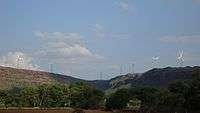
Windmills set up to generate wind energy, are posing a threat to the very existence of rare hyenas and wolves at Gajendragad.[9][10] Earlier Gajendragad was recognised as a safe haven for highly endangered species like the Indian grey wolf and striped hyenas, but then came wind farming and windmills with huge noisy fans and human traffic to maintain these machines. It drove away these species from their habitat.
Notable personalities from Gajendragad
Vedanta, Nyaya, Vyakaran
- Raghavendra Acharya.[11] (19th century)
Gajendragadkars of Satara (A Tradition of Scholarship in Vedanta, Nyaya and Vyakaran)[12]
The Raghavendra Acharya (Gajendragadkar) family belongs to the Madhav School. Sudhindhra Swami, a latter day head of the Madhav Peeth, is the oldest known member of this family. The seat of the family was the town of Gajendragad. Raghavendra Acharya was a grandson of Sudhindra Swami.
Raghavendra Acharya was a profound scholar in Vedanta, Vyakaran (Grammar), Nyaya (Law), Mimamsa and Alankar. Raghavendra Acharya lived in Gajendragad, Karnatak, South India. His house was in effect a pathashala or school for students. Pratapsimha Emperor of Satara of Maratha Empire sent messenger with royal request that Raghavendra Acharya to shift to Satara with his family to become the Raj Pandit. He accepted the offer of the Emperor. Since the family shifted from Gajendragad to Satara, hence the family name GajendragadKar.
Law and Justice
Prahlad Balacharya Gajendragadkar was the Chief Justice of India from February 1964 to March 1966.
Freedom Fighters and Politicians
This small town was also proudly involved in the freedom struggle. Pandit Jawaharlal Nehru & Sardar Vallabhbhai Patel visited Gajendragad. Photos of their visit are displayed in the L C Patted Store. The small village of Rajur nearby was a centre of the freedom fight. Siddamma Patil (of the Revadi family of Gajendragad) was close to the Nehru family and a very close associate of Andanappa Doddameti (in whose house Mahatma Gandhi stayed for a night – in the village of Jakkali. After independence Gajendragad supported the Indian National Congress. Late Andanappa Kundaragi from Gajendragad became the President of the Dharwad District Congress Committee. He was known by the nickname "Dajikaka".
Kannada Sahitya Sammelana
A Kannada Sahitya Sammelana (Literature Meet) was held from the 11 to 13 February 2011 at Gajendragad.
Geography
Gajendragarh is located at 15.73°N 75.98°E.[13] It has an average elevation of 643 metres (2109 feet).
Demographics
As of 2001 India census,[14] Gajendragarh had a population of 28,227. Males constitute 51% of the population and females 49%. Gajendragarh has an average literacy rate of 62%, higher than the national average of 59.5%: male literacy is 74%, and female literacy is 51%. In Gajendragarh, 14% of the population is under 6 years of age.
See also
- Ghorpade
- Sandur (princely state)
- Mudhol State
- Gooty
- North Karnataka
- Tourism in North Karnataka
- Badami, Pattadakal, Aihole, Mahakuta
- Kuknur
- Mahadeva Temple (Itagi)
- Sudi
- Gadag District
- Mudhol Hound
Gallery
Photo Gallery |
|---|
|
References
| Wikimedia Commons has media related to Gajendragarh. |
- "MUSALMA'N AND MARA'THA PERIOD. Bombay Gazetteer, Maráthás and Nizám against Tipu" (PDF). Retrieved 14 November 2008.
- "Crown Representative's Records – Indian States Residencies". Retrieved 14 November 2008.
- "Raja of Mudhol, A BIRD'S-EYE VIEW". Retrieved 14 November 2008.
- "GAJENDRAGAD (Jagir)". Retrieved 14 November 2008.
- "Tipu Sultan (1782–1799)". Retrieved 16 March 2009.
- SPLENDOURS OF ROYAL MYSORE
- "Treaty of Gajendragad". Retrieved 17 March 2009.
- "MMTC to expand wind energy project in Karnataka". Hemanth CS Bangalore DNA. Retrieved 9 June 2011.
- "Windmills blowing away wolves and hyenas". Archived from the original on 29 March 2008. Retrieved 14 November 2008.
- "Endangered hyenas and wolves rapidly disappearing from Gajendragad". Archived from the original on 11 May 2008. Retrieved 14 November 2008.
- "Gajendra-Gad-Kar School, Raghavendra Acharya". Retrieved 30 December 2012.
- Archived 31 December 2008 at the Wayback Machine
- Falling Rain Genomics, Inc – Gajendragarh. Fallingrain.com. Retrieved on 2011-11-25.
- "Census of India 2001: Data from the 2001 Census, including cities, villages and towns (Provisional)". Census Commission of India. Archived from the original on 16 June 2004. Retrieved 1 November 2008.

